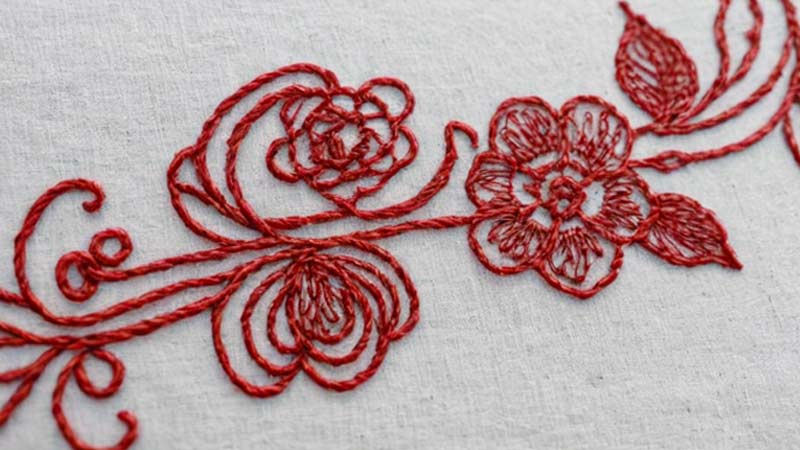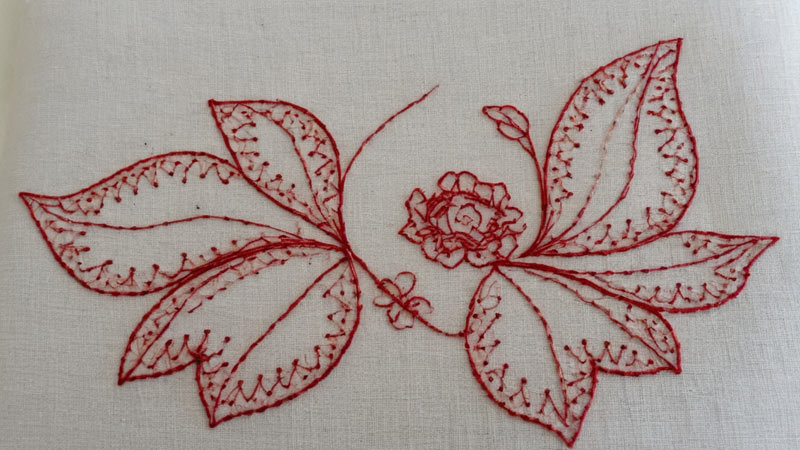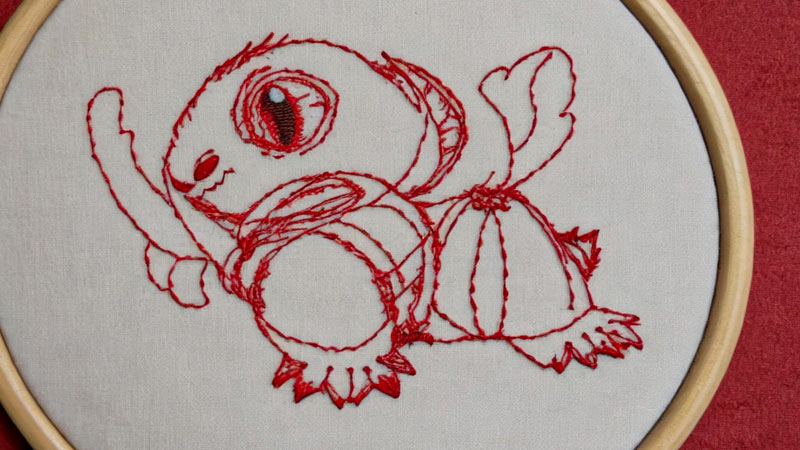Weaving a thread of history, tradition, and simplicity, redwork embroidery continues to fascinate the world of needlecraft.
A stitch in time, as they say, saves nine, but here’s a stitch that does more than mend. It tells stories. The question on your mind might be: “What stitch is used for redwork?”
Redwork embroidery employs a simple yet versatile outline or stem stitch. It’s an art form rooted in late 19th century America, becoming a beloved pastime of women with little access to fancy sewing materials.
They would bring life to white linens with their crimson threads and basic stitches. That said, what makes this particular style so unique? Why do we continue to talk about it even today? Well, it’s all about the elegance of simplicity.
Traditional redwork embroidery has no room for complex techniques or an array of colors; a single hue does all the talking. It just shows you don’t always need elaborate methods or materials to create something beautiful.
Sometimes simplicity speaks louder than complexity, and that couldn’t be truer than in the case of redwork embroidery.

What is Redwork?
Diving into the vibrant world of embroidery, I can’t help but shine a light on one particular style rich in history and simplicity: redwork embroidery. So, what is redwork embroidery?
It’s an old form of traditional embroidery where designs are hand-stitched using red thread on white or cream fabric. The beauty lies in its simplicity – no multitude of colors to juggle, just bold and striking red against a neutral backdrop.
Tracing back the roots of traditional redwork embroidery takes us to the late 19th century. It became popular in America during this time due to its affordability and ease of learning.
The stitch used was predominantly the simple outline or stem stitch, making it accessible for even beginners to try their hands at it.
The charm of redwork does not just lie in its aesthetic appeal; there’s a cultural significance behind it, too. This style was often used for practical items such as dish towels and pillowcases, transforming mundane everyday objects into art.
Learning to do redwork embroidery opens doors to creating beautiful patterns with minimal fuss. From intricate floral designs to adorable animal motifs, you can bring any image or idea to life using just one color thread!
So why has Redwork stuck around? Besides being easy and cost-efficient, there’s something undeniably captivating about monochromatic designs that have stood the test of time.
Whether you’re an experienced embroiderer looking for a new challenge or a beginner starting your journey – delving into traditional redwork embroidery might be your next creative adventure!
History of Redwork

Redwork embroidery has a rich and fascinating history that spans continents and centuries. Originating during the Victorian era in Europe, redwork quickly became popular due to its simplicity, affordability, and striking aesthetic.
Origins in Europe
Redwork embroidery traces its roots back to the Victorian era in Europe. Emerging during a period marked by intricate needlework and decorative arts, redwork stood out for its simplicity and affordability.
The technique involved using red floss exclusively on white or off-white fabric, with the color choice driven by practicality rather than purely aesthetic considerations.
Spread to America
As European immigrants ventured to new lands, they brought their embroidery traditions, including redwork. This transfer of culture led to the proliferation of redwork in America, where it quickly gained popularity among women.
By the late 1800s, redwork had become a common practice in American households, embraced for its versatility and durability.
Sewing Bee Culture
In an era where sewing and embroidery were essential skills for women, gatherings such as sewing bees provided opportunities for socializing and skill-sharing.
These communal events were where many pieces of redwork embroidery were created, showcasing the creativity and craftsmanship of participants.
Innovation with Printed Patterns
Around 1910, a significant innovation occurred in redwork embroidery with the introduction of printed patterns directly onto quilt blocks. This advancement revolutionized the craft, making it easier for individuals to create intricate designs without manual tracing.
It marked a shift towards mass production and standardized patterns in redwork.
Continued Appeal
Despite changes in technology and societal roles, redwork embroidery continues to captivate enthusiasts today. Its timeless charm and simplicity appeal to seasoned stitchers and newcomers, ensuring the redwork legacy is a cherished part of the needlework tradition.
From its humble origins in Europe to widespread popularity in America and beyond, redwork remains a beloved and enduring form of embroidery.
The Importance of Choosing the Right Stitch for Redwork

Selecting the appropriate stitch for Redwork embroidery is paramount to the success and aesthetic appeal of the finished piece.
Redwork, a traditional form of embroidery characterized by its exclusive use of red thread on a white or off-white fabric, relies heavily on the stem or outline stitch for several crucial reasons.
Preservation of Tradition
The stem stitch has been synonymous with redwork embroidery since its inception.
Embroiderers honor and preserve redwork’s rich heritage and historical significance by choosing this stitch. It pays homage to the techniques and craftsmanship of past generations while ensuring the continuation of this time-honored tradition.
Emphasis on Clean Lines and Precision
Redwork designs often feature intricate outlines and delicate details. The stem stitch produces clean, smooth lines, making it the ideal choice for capturing the delicate nuances of these designs.
Its consistent appearance ensures that each stitch contributes to the overall precision and clarity of the embroidery, enhancing its visual appeal.
Versatility and Adaptability
The stem stitch’s versatility allows it to adapt seamlessly to various design elements, from gentle curves to straight lines. This flexibility empowers embroiderers to execute diverse motifs and patterns efficiently, unleashing their creativity and allowing for intricate and captivating compositions.
Attention to Detail and Quality Craftsmanship
In redwork embroidery, every stitch matters. The stitch choice reflects the embroiderer’s commitment to quality craftsmanship and attention to detail.
By meticulously selecting the stem stitch and executing it with care, embroiderers demonstrate a dedication to excellence, ensuring that each stitch contributes to the overall beauty and integrity of the finished piece.
Consistency and Cohesion
Consistency is vital in redwork embroidery, where uniformity of stitches enhances the coherence and visual impact of the design.
The stem stitch’s ability to produce consistent results ensures that the embroidery maintains a cohesive and harmonious appearance, creating a sense of unity and balance throughout the piece.
Exploring Popular Stitches for Redwork Embroidery: A Guide to Traditional Techniques

Redwork embroidery, with its timeless charm and simplicity, relies on various stitches to bring designs to life. While redwork traditionally emphasizes using red thread on white or off-white fabric, the stitches employed in this art form are versatile and can create intricate and captivating patterns.
Let’s delve into some of the most popular stitches used in redwork embroidery:
Stem Stitch
Stitch is a cornerstone of redwork embroidery, renowned for its versatility and ability to create smooth, flowing lines. Named for its resemblance to plant stems, this stitch is ideal for outlining patterns, forming letters, and adding detail to designs.
Its simplicity and elegance make it a favorite among embroiderers for redwork projects.
French Knot
The French knot adds texture and dimension to redwork designs by creating tiny, tightly wound knots on the fabric surface. While it may appear complex, mastering this stitch can add depth and intricacy to patterns, enhancing visual appeal.
Satin Stitch
The satin stitch is often used in redwork embroidery to fill larger areas with color, providing a smooth, glossy finish to designs.
Its ability to create solid blocks of color adds richness and depth to patterns, making it a versatile choice for adding detail and vibrancy to redwork projects.
Backstitch
Known for its strength and durability, the backstitch forms solid lines that hold up well over time, making it suitable for creating outlines and adding definition to redwork designs.
Its straightforward nature and ability to produce crisp, uniform lines make it a staple of redwork embroidery.
Cross-Stitch
While not as frequently used as other stitches in redwork embroidery, the cross-stitch can add an interesting geometric element to designs.
By creating X-shaped stitches, embroiderers can achieve intricate patterns and textures, adding visual interest and complexity to their redwork projects.
Split Stitch
is another classic stitch commonly used in redwork embroidery. By splitting the thread of a previous stitch, embroiderers can easily create smooth outlines and intricate details, adding depth and dimension to their designs.
Chain Stitch
The chain stitch is beloved for its simplicity and versatility in redwork embroidery. By forming linked thread loops, embroiderers can create elegant outlines and fills, adding texture and interest to their designs.
Conclusion
So there you have it. I’ve walked you through the fascinating world of redwork embroidery, its history, and how to master this traditional technique. From what we’ve discussed, it’s clear that a simple running stitch is used in redwork.
While seemingly straightforward, redwork embroidery holds a unique appeal that has stood the test of time.
The simplicity of using one color – traditionally red – and one type of stitch doesn’t limit creativity but rather opens up endless opportunities for intricate designs and storytelling.
It’s no surprise that many still turn to this form of embroidery today. With minimal materials required and soothing repetitiveness, it’s an ideal starting point for beginners while offering enough depth to keep experienced embroiderers engaged.
Remember these critical takeaways about redwork:
- It uses a running stitch
- It typically features red thread on a white or neutral fabric
- It originated in Europe before gaining popularity in America during the 19th century
While exploring different embroidery techniques, I’ve found that each has unique charm and historical significance. And indeed, redwork sits comfortably among them all with its rich background and timeless beauty.
If you haven’t already given traditional redwork embroidery a go, why not try it? You might fall in love with this simple yet charming art form – as countless others have over centuries!
Leave a Reply